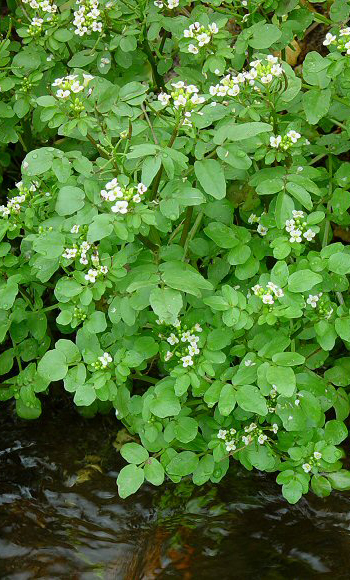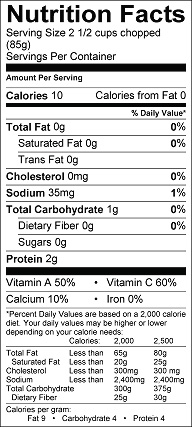Contents:
Common Names | Parts Usually Used | Plant(s) & Culture | Where Found | Medicinal Properties | Biochemical Information
Legends, Myths and Stories | Uses | Formulas or Dosages | Nutrient Content | How Sold | Warning | Bibliography
Scientific Names

- Nasturtium officinale L.
- Cruciferae
- Crucifer family
Common Names
- Scurvy grass
- Tall nasturtium
Parts Usually Used
Leaves, roots, young shoots
Back to Top
Description of Plant(s) and Culture
Watercress is a succulent, perennial plant that is cultivated for its leaves, which are principally used as salad greens or garnishes. Forms large colonies in cool running water; a creeping, weak, stem with root at the nodes and turns up to form leafy shoots, 1-2 feet in length, generally extends with its leaves above the water. The smooth, somewhat fleshy, compound, dark green leaves are odd-pinnate with 1-4 pairs of small, oblong or roundish leaflets. The small, white or pale purple, four-petaled flowers bloom in elongating terminal racemes from May to September. The fruit is a long, curved, linear-cylindric, partitioned pod borne more or less upright.
Back to Top
Where Found
Native to Europe and naturalized in the United States and some parts of Canada. It thrives in clear, running, cold water and is found in ditches, springs, and streams everywhere. Widely cultivated for use in salads.
Back to Top
Medicinal Properties
Diuretic, expectorant, purgative, stimulant, stomachic, tonic
Back to Top
Biochemical Information
Calcium, chlorine, cobalt, copper, tannin, fluorine, iodine, iron, manganese, phosphorus, sulfur, vanadium, vitamins A, B1, B2, C, D, and zinc.
Back to Top
Legends, Myths and Stories
Watercress is high in favor with nutritional advisors to the armed forces for soups and salads for the energy it produces. Good for dieters, has low carbohydrate content and more iron than spinach. Fed to children with weak bones and soft teeth because it contains lime high in sulphur content. Given in tablet form for eczema.
The Greeks referred to watercress as a “wit-producing food.”
Back to Top
Uses
Good for urinary bladder problems. Promotes kidney function. Helps heart disease by relieving fluid retention. Relieves indigestion and stops gas formation. Stimulates rate of metabolism and is taken as a spring tonic.
Watercress is recommended for gout, scurvy, mild digestive disturbances, anemia, and catarrh of the upper respiratory tract. Very effective as an expectorant, it is also beneficial for tuberculosis, scurvy, anemia, and eczema. Its high vitamin C content makes it a good illness preventative. Very good as a post-partum (after childbirth) remedy to prevent infections. Having a modest iodine content, cress is a dietary remedy for thyroid problems. The iodine in watercress is present in the right amount and combination with other substances. If you have thyroid problems, such as palpitations, oversensitivity to every little influence, or enlargement of the gland itself, you should definitely eat watercress on a regular basis. You will find it a marvelous remedy if you lack vitality and are always listless and tired, symptoms that are usually caused by the poor function of the endocrine glands. In addition, the richness of its mineral, iron and iodine content stimulates glandular activity. Limited loss of hair caused by a fungus can be remedied by an application of watercress juice.
Leaf extracts are used clinically in India to correct vitamin deficiency.
Watercress stimulates the appetite. Fresh leaves may be used in salads or as a garnish, raw or deep-fried. Also in chopped form, added to appetizers, eggs, cheese, and fish.
Back to Top
Formulas or Dosages
Watercress must be used fresh.
Infusion: use 1 tsp. young shoots in 1/2 cup water. Take 1/2 cup, freshly made, 3 times a day. To maintain the greatest possible vitamin content, do not steep a long time or allow to boil.
Juice: take 1 tsp. in milk or water, 3 times a day. Fresh watercress juice is easily obtained with an electric vegetable juicer.
Back to Top
Nutrient Content
Iodine, niacin, magnesium, manganese, phosphorus, calcium, vitamins A, B1, B2, C and E and zinc.

How Sold
Fresh plant in grocery
Back to Top
Warning
Do not harvest leaves from polluted waters. Poisonings have resulted from eating leaves from plants growing in polluted waters, from which the plant has absorbed heavy metals and toxins.
Excessive or prolonged use can lead to stomach upset and kidney problems. It should not be taken daily and no longer than 4 weeks even with interruptions. The juice should not be taken undiluted, because it can produce inflammations in the throat and stomach. Some doctors caution against use during pregnancy.
Back to Top
Bibliography
![]() The Herb Book
The Herb Book, by John Lust, Bantam Books, 666 Fifth Avenue, New York, NY. copyright 1974.
![]() Eastern/Central Medicinal Plants
Eastern/Central Medicinal Plants, by Steven Foster and James A. Duke., Houghton Mifflin Company, 215 Park Avenue South, New York, NY 10000
![]() The Herbalist Almanac
The Herbalist Almanac, by Clarence Meyer, Meyerbooks, publisher, PO Box 427, Glenwood, Illinois 60425, copyright 1988, fifth printing, 1994
![]() The Nature Doctor: A Manual of Traditional and Complementary Medicine
The Nature Doctor: A Manual of Traditional and Complementary Medicine, by Dr. H.C.A. Vogel; Keats Publishing, Inc., 27 Pine Street (Box 876) New Canaan, CT. 06840-0876. Copyright Verlag A. Vogel, Teufen (AR) Switzerland 1952, 1991
 The Magic of Herbs
The Magic of Herbs, by David Conway, published by Jonathan Cape, Thirty Bedford Square, London, England. (Out of print)
![]() Planetary Herbology
Planetary Herbology, by Michael Tierra, C.A., N.D., O.M.D., Lotus Press, PO Box 325, Twin Lakes. WI 53181., Copyright 1988, published 1992
![]() American Folk Medicine
American Folk Medicine, by Clarence Meyer, Meyerbooks, publisher, PO Box 427, Glenwood, Illinois 60425, 1973
![]() Indian Herbalogy of North America
Indian Herbalogy of North America, by Alma R. Hutchens, Shambala Publications, Inc., Horticultural Hall, 300 Massachusetts Avenue, Boston, Massachusetts 02115, 1973
![]() Prescription for Nutritional Healing, Fifth Edition: A Practical A-to-Z Reference to Drug-Free Remedies Using Vitamins, Minerals, Herbs & Food Supplements
Prescription for Nutritional Healing, Fifth Edition: A Practical A-to-Z Reference to Drug-Free Remedies Using Vitamins, Minerals, Herbs & Food Supplements, by James F. Balch, M.D. and Phyllis A. Balch, C.N.C., Avery Publishing Group, Inc., Garden City Park, NY
![]() Webster’s New World Dictionary
Webster’s New World Dictionary, Third College Edition, Victoria Neufeldt, Editor in Chief, New World Dictionaries: A Division of Simon & Schuster, Inc., 15 Columbus Circle, New York, NY 10023
 An Instant Guide to Medicinal Plants
An Instant Guide to Medicinal Plants, by Pamela Forey and Ruth Lindsay, Crescent Books (January 27, 1992).
![]() The Yoga of Herbs: An Ayurvedic Guide to Herbal Medicine
The Yoga of Herbs: An Ayurvedic Guide to Herbal Medicine, by Dr. David Frawley & Dr. Vasant Lad, Lotus Press, Twin Lakes, Wisconsin, Second edition, 1988.
 The Rodale Herb Book: How to Use, Grow, and Buy Nature’s Miracle Plants (An Organic gardening and farming book)
The Rodale Herb Book: How to Use, Grow, and Buy Nature’s Miracle Plants (An Organic gardening and farming book), edited by William H. Hylton, Rodale Press, Inc. Emmaus, PA, 18049., 1974
